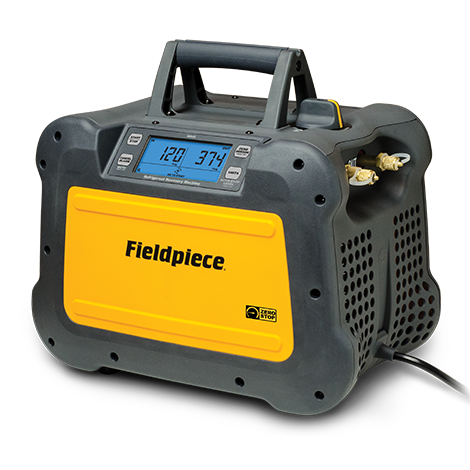
In the HVACR industry, proper refrigerant management is crucial for both environmental protection and system efficiency. One essential tool in this process is the refrigerant recovery machine. A refrigerant recovery machine ensures compliance with environmental regulations while maintaining system performance. But what exactly is a refrigerant recovery machine, and how does it work? Let’s explore its function, importance, and key considerations when choosing the right one.
A refrigerant recovery machine is a specialized device designed to remove refrigerants from HVACR systems such as air conditioners, refrigerators, and commercial HVACR units. This process is necessary to prevent the release of harmful refrigerants into the atmosphere, as many of these substances contribute to ozone depletion and global warming, in addition to the financial benefit of reclaiming valuable refrigerant for future use.
These machines operate by safely extracting the refrigerant from the system and storing it in a designated recovery cylinder. The recovered refrigerant can then be recycled, reclaimed, or properly disposed of, depending on its condition and applicable regulations.
Refrigerant recovery machines function by using a series of components that enable the safe and efficient removal of refrigerant. The process typically involves three main steps. Step one is refrigerant extraction: the machine connects to the HVACR system via service or vacuum hoses, creating a closed-loop system. It then pulls refrigerant from the system through the recovery machine. Next is the compression and cooling stage. Inside the machine, the refrigerant is compressed and cooled to transition it from a gas to a liquid or maintain its gaseous state, depending on the recovery method used. The speed of the recovery process can vary depending on the state of the refrigerant, so recovery machines such as the Fieldpiece MR45 that can vary speed based on refrigerant state can significantly increase the speed of the recovery process. Finally, the refrigerant is transferred to a certified recovery tank, preventing its release into the environment. It can later be processed for reuse or disposal according to industry standards.
There are three primary methods of refrigerant recovery, each with its advantages and specific applications:
Liquid Recovery: This method involves removing refrigerant in its liquid state, typically the fastest process
Vapor Recovery: This method involves extracting refrigerant in its vapor form
Push-Pull Recovery: This technique utilizes both the liquid and vapor ports of a recovery cylinder to increase recovery speeds on large systems. A loop is made between the cylinder, recovery machine, and system, which when active pushes liquid from the system into the cylinder. This pushed vapor out of the cylinder, through the recovery machine, and back into the system, increasing system pressure and output of liquid refrigerant to the cylinder. Note, this is not as common or effective with residential or smaller systems.
Environmental Protection
Refrigerants such as R-22 and hydrofluorocarbons (HFCs) have been linked to ozone depletion and global warming. By using a recovery machine, HVACR professionals significantly reduce the release of harmful gases, ensuring compliance with the Clean Air Act and EPA Section 608 regulations. Additionally, recovery machines that halt the recovery process at 0inHg can offer further protection by preventing the introduction of air into the system and recovery cylinders in systems where leaks are present.
Regulatory Compliance
Governments and regulatory agencies require HVACR technicians to recover refrigerants during system repairs or decommissioning. Failing to comply can lead to heavy fines and legal consequences.
Cost Efficiency
Reclaimed refrigerants can be cleaned and reused, reducing the need to purchase new refrigerants. With the rising cost of refrigerants due to phase-outs of older substances, as well as common shortages of high-demand refrigerants, recovery and reuse provide significant cost savings to the technician and contractor.
System Longevity and Performance
Proper refrigerant recovery prevents contamination and moisture from entering HVACR systems, which helps maintain their efficiency and longevity, reducing callbacks and equipment breakdown, and increasing customer satisfaction.
When choosing the right refrigerant recovery machine, there are several details to keep in mind. Look for a machine with high recovery rates, especially if you handle large systems. Faster recovery times improve efficiency and reduce downtime. A compact, lightweight, and rugged design ensures easy transport and durability, especially for field technicians who move between job sites frequently. Ensure that the machine supports the refrigerants you commonly work with, including newer low-global-warming-potential (GWP) refrigerants. Features such as overheat protection, high-pressure shut-off, and filter systems enhance safety and machine longevity. User-friendly controls, clear display screens, and automatic functions make refrigerant recovery machines easier to operate and reduce the likelihood of errors, and smart functions that halt recovery to prevent the introduction of air into systems and cylinders further increase recovery effectiveness.
A refrigerant recovery machine is an indispensable tool for HVACR professionals, ensuring environmental safety, regulatory compliance, and cost-effective refrigerant management. As regulations continue to evolve and refrigerants transition to more environmentally friendly alternatives, having a reliable refrigerant recovery machine will remain a necessity for any HVACR technician or company dedicated to responsible refrigerant handling. Further questions? Looking for the right refrigerant recovery machine for you? Read more about the Fieldpiece MR45 today and increase your recovery speed and effectiveness.